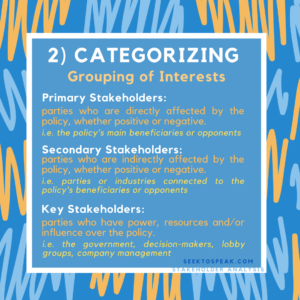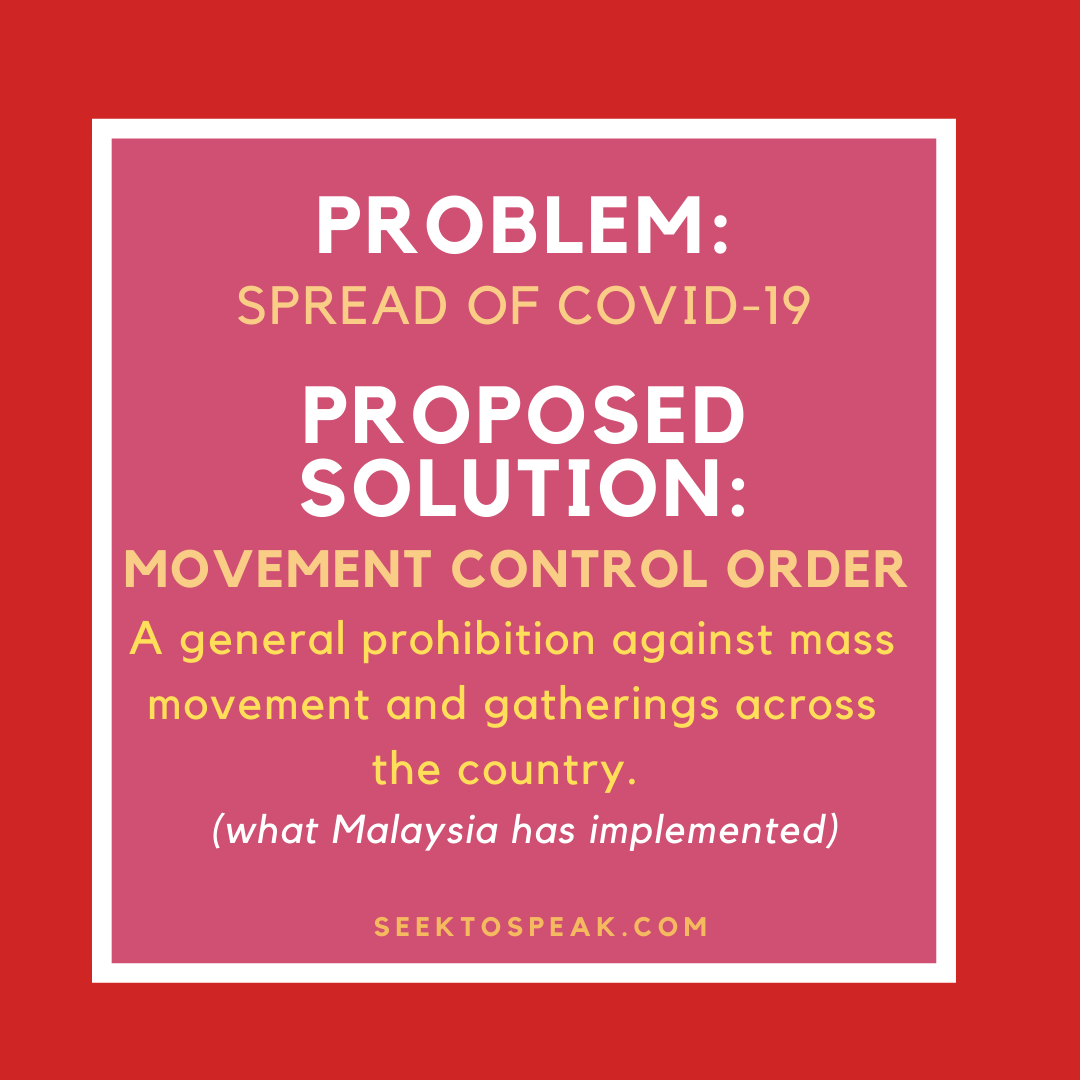With the rising fear of Covid-19, governments around the world are quick to introduce and implement emergency short-term policies to address and contain the spread of the virus. Expediency and enforcement are key. However, long term policies require a longer thought process, typically crafted with sustainability and certainty in mind.
An important step in determining the efficacy of your policy depends on the extent of its benefit vis-a-vis its cost. Is your policy beneficial? Are there harms involved? This applies to the Visualisation Stage of a policy speech, as discussed in the first installment of this series here.
In this series, we will look at how to visualize your policy through a Stakeholder Analysis in order to better contextualize your policy to reality. This is where we start “Playing People” by looking at the different parties involved in the policy, to get a feel of how their lives are or will be affected by the problem and your policy.
Stakeholder Analysis
In simple terms, Stakeholders are individuals, institutions, or parties directly or indirectly affected by your policy. When presenting a policy speech, speakers tend to overlook analyzing the problem from different perspectives, preventing the speaker from being aware of potential policy harms or indirect implications. A Stakeholder Analysis mitigates this risk, by assessing your policy from the lenses of all stakeholders. Utilizing the Stakeholder Analysis in a speech would require the following steps:
1) Brainstorming – Identification of Stakeholders
The first step would be to brainstorm and identify the stakeholders involved in your policy. This can be done by simply asking and answering the following questions,
Who are the beneficiaries and proponents of the policy?
Who are the opponents and parties harmed by the policy?
Is the government and/or public services needed or affected by the policy?
How will the policy affect various sectors within the nation?
How will the policy affect the rest of the world?
The above exercise allows you to identify stakeholders and outline their respective interests in relation to the policy. Such interests are varied and include economic, health, security, environmental, social national, international, and even emotional interests. Stakeholders are not limited to persons but could be institutions, companies, industries, communities, countries and even, concepts or ideas.
2) Categorizing – Grouping of Interests
The second step would then be to identify the nature and extent of the various stakeholder interests. During this step, stakeholders will be categorized into the following broad groupings:
Primary: parties who are directly affected by the policy, whether positive or negative. i.e. the policy’s main beneficiaries or opponents
Secondary: parties who are indirectly affected by the policy, whether positive or negative. i.e. parties or industries connected to the policy’s beneficiaries or opponents
Key: parties who have power, resources and/or influence over the policy. i.e. the government, policy or decision-makers, lobby groups, management of the company
3) Addressing & Applying – Highlighting benefits, Mitigating harms
The third step would be the step that is most essential and relevant to your speech. This is where everything comes together and speakers are able to use their critical-thinking and problem-solving skills to:
Apply the information to the different stages of Monroe’s Motivated System (MMS); and
Address the various stakeholder interests.
The following are ways to use the information gained from Step 1 and Step 2 above within MMS:
1) Attention & 2) Need Stages: This is where you look at the beneficiaries of the policy, i.e. the Primary Stakeholders, and what would happen to such stakeholders should the problem persist and nothing is done about it.
3) Satisfaction Stage: When introducing your policy, you should also highlight the Key Stakeholders you had identified. How can the government implement the policy? How can decision-makers be swayed? Where would the funding come from? This is also where you deal with the opponents of the policy, the Primary Stakeholders. How do we address their concerns and issues? How can you mitigate any risk or harm to them?
4) Visualization Stage: This is where you highlight and emphasize the various benefits or advantages of your policy to its beneficiaries, the Primary and Secondary Stakeholders. How are these parties positively affected? How far do these benefits go?
5) Action Stage: This is where you remind the audience of the policy’s Key Stakeholders and how the audience can play a role in convincing or reaching out to such stakeholders to ensure your policy is a success.
Application of Stakeholder Analysis
For example,
Step 1: Brainstorming
1) Who are the beneficiaries of the policy? Public Health, High-risk citizens like the elderly and infirmed, Infected Persons, Healthcare Providers, Pharmaceutical Companies, General Populace, E-commerce, Courier Companies.
2) Who are the parties harmed by the policy? Retailers, Airline Companies, Travel Industry, Small to Medium Enterprises, NGOs, Freelance Workers, Employers and Employees of affected companies/industries.
3) Is the government and/or public services needed or affected by the policy? Yes. Police and army personnel for enforcement. Parliament and ministers to provide funding and mobilize resources. For example, the Ministry of Health is to provide healthcare workers, sanitation equipment, and ventilators.
4) How will the policy affect various sectors within the nation? Health industry will not be overwhelmed with Public Health maintained. However, there will be a decline in the Retail and Travel sector.
5) How will the policy affect the rest of the world? There will be a delay in the movement of Covid-19 between countries. However, the measure may contribute to the global trade and market slump.
Step 2: Categorising

1) Primary: Public Health, High-risk Citizens, Infected Persons, General Populace, Healthcare Providers, Travel Industry, Employers, Airline Companies
2) Secondary: General Populace, Pharmaceutical Companies, E-commerce, Courier Companies. Small to Medium Enterprises, NGOs, Freelance Workers, Employers and Employees of affected companies/industries
3) Key: Government and its agencies and in particular, the Prime Minister’s Department, Ministry of Health, Ministry of Defence, and Foreign Ministry.
Step 3: Addressing & Applying

1) Attention & 2) Need Stage
As of 27 March 2020, Malaysia has reported 2,031 Covid-19 cases and 23 related deaths (Infected Persons). Globally, the disease has taken more than 24,090 lives with 75% of victims being over the age of 60 with pre-existing health conditions (Elderly and Infirmed). The World Health Organisation (WHO) is concerned about how healthcare systems can be managed as 532,263 are infected worldwide. “Take one look at what’s happening in some health systems around the world. Look at the intensive care units completely overwhelmed. Doctors and nurses are utterly exhausted,” commented Mike Ryan, executive director of the WHO’s emergency program (Healthcare Providers).
3) Satisfaction Stage
The Movement Control Order (MCO) which will last until April 14 entails a general prohibition against movement and gatherings across the country. The government will enact new legislation that would see all business premises, places of worship and education institutions closed. This prohibition will include a travel ban to and from Malaysia as well as between local states. Enforcement of such rules will be aided by the Ministry of Defence and Foreign Ministry. (Key Stakeholders: Government and its agencies)
In mitigating the economic risks of MCO, the government will give tax breaks due those in the travel and retail industry with a freeze in the payment of interest on loans. Financial aid will also be given to SMEs and NGOs to weather the partial lockdown with a temporary freeze on layoffs. Citizens are also allowed to withdraw up to RM500 from their Employee Provident Fund once a month for supplies. (Primary and Secondary Stakeholders negatively affected: Retail & Travel Industries, Small Companies, NGOs, and Employees/Employers)
4) Visualization Stage
This policy delays the spread of Covid-19 between borders, states and within the city, keeping the elderly and infirmed protected. This delay allows healthcare providers and healthcare authorities to properly prepare for an emergency onslaught by bolstering their bed count, ventilator capacity and recruitment of workers. With the health system not overwhelmed, better treatment can be given to those infected with Covid-19 and existing patients with debilitating diseases can remain treated, reducing the rate of avoidable deaths. Public health will be improved as citizens come to grips with the seriousness of the pandemic as well as the risk of mass infection. (Primary and Secondary Stakeholders positively affected: Public Health, High-risk Citizens, Infected Persons, General Populace, and Healthcare Providers)
5) Action Stage
Therefore, I call all of you to action by demanding that the government implement and enforce a Movement Control Order over the country until 14 April 2020. Contact your local minister, sign a petition, and share this cause on social media. We have to do whatever it takes to keep ourselves safe and healthy. This is a war against Covid-19 and we need everyone’s support to make this policy a success! (Key Stakeholder: The Government)


